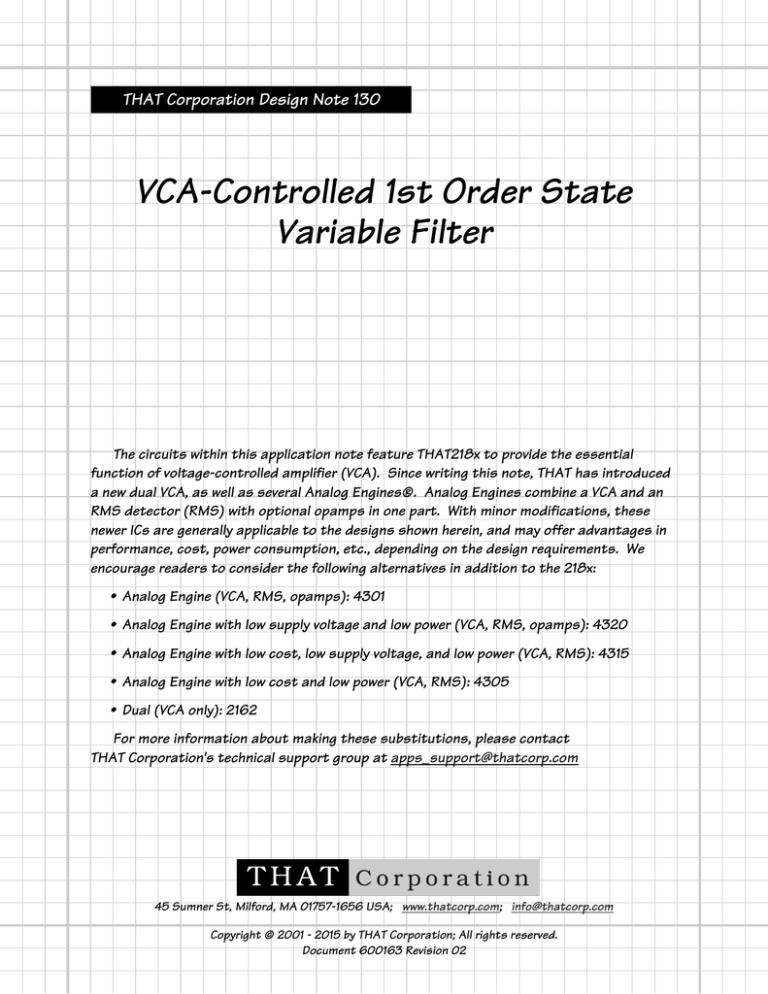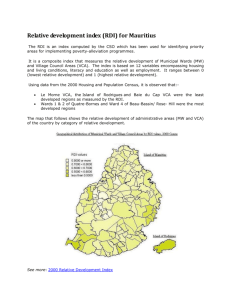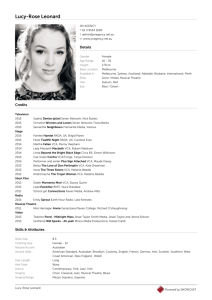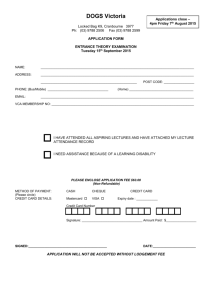
THAT Corporation Design Note 130
VCA-Controlled 1st Order State
Variable Filter
The circuits within this application note feature THAT218x to provide the essential
function of voltage-controlled amplifier (VCA). Since writing this note, THAT has introduced
a new dual VCA, as well as several Analog Engines®. Analog Engines combine a VCA and an
RMS detector (RMS) with optional opamps in one part. With minor modifications, these
newer ICs are generally applicable to the designs shown herein, and may offer advantages in
performance, cost, power consumption, etc., depending on the design requirements. We
encourage readers to consider the following alternatives in addition to the 218x:
y Analog Engine (VCA, RMS, opamps): 4301
y Analog Engine with low supply voltage and low power (VCA, RMS, opamps): 4320
y Analog Engine with low cost, low supply voltage, and low power (VCA, RMS): 4315
y Analog Engine with low cost and low power (VCA, RMS): 4305
y Dual (VCA only): 2162
For more information about making these substitutions, please contact
THAT Corporation's technical support group at apps_support@thatcorp.com
45 Sumner St, Milford, MA 01757-1656 USA; www.thatcorp.com; info@thatcorp.com
Copyright © 2001 - 2015 by THAT Corporation; All rights reserved.
Document 600163 Revision 02
VCA-Controlled 1st Order State
Variable Filter
THAT Corporation Design Note 130
VCAs are widely used throughout the audio signal chain to control amplitude, especially
where dynamic gain control is desired. A less well known application of these devices is in
dynamically controllable filters. VCAs ease the design of these circuits, and avoid the
”zipper noise” which plagues circuits using stepped attenuators.
The Theory
Figure 1 shows the basic VCA-based first order state variable filter. For our purposes, we
can state the transfer function of the VCA as being
VCAOUT
VCAIN
= G$
ZOUT
ZIN
where G is the gain of the VCA.
This is much like the transfer function of an inverting amplifier, but without the sign
change, and with an additional, variable gain term. This lack of inversion simplifies the circuit
and its analysis, since U2A can now be a simple inverting summer, rather than the differential stage normally found at this location. We can state the high pass output to be
)
( −R )
HighPass = Input$ ( −R
R +LowPass$ R = −Input−LowPass
(equation 1)
and the low pass output to be
1
sCSET
LowPass = HighPass$
RSET
G
sCSETRSET
G = HighPass$
(equation 2)
Substituting, we find that
HighPass = −Input−HighPass$
G
sCSETRSET
and
R
High Pass
R
Input
Cc
U1
2180A
2
R
2
EC+
U2A
1
3
Rset
1
5532
4
SYM
IN
EC-
3
GND
6
Cset
V+
7
V+
V-
OUT
8
5
Vcontrol
2
3
U3
LF351
6
Low Pass
1 5
Rbias
V-
Figure 1. VCA-controlled 1st order state variable filter
Copyright © 2002 - 2015
by THAT Corporation
All rights reserved
45 Sumner St; Milford, MA 01757 USA; www.thatcorp.com; info@thatcorp.com
Design Note 130
Page 2 of 6
Doc 600163 Rev 02
VCA-Controlled 1st Order State
Variable Filter
THAT Corporation Design Note 130
HighPass$ 1 +
G
sCSETRSET
= −Input
This result can be reduced to
HighPass
Input
=
−1
G
sC SET R SET
1+
−S
=
G
C SET R SET
S+
which is of the form of a typical first order high pass filter, but with the corner frequency
dependent on VCA gain. Combining equations 1 and 2, we can similarly derive the lowpass
output to be:
LowPass(
sCSETRSET
) = −Input−LowPass
G
which after cross-multiplication yields
LowPass = −Input$
G
sCSETRSET
G
sCSETRSET
−LowPass$
which becomes
LowPass $ 1 +
G
sCSETRSET
G
sCSETRSET
= −Input
This result may be reduced to
LowPass
Input
=
−
G
sC SET R SET
1+
G
sC SET R SET
=
G
C SET R SET
−
S+
G
C SET R SET
which is of the form of a typical first order low pass filter, but again with the corner
frequency dependent on VCA gain.
R5
10k
C6
High Pass
R4 10p
Input
+5
C2
47u
From uP
R3
10k
2 U2A
10k
3
5532
U4
Ref+
Data
Out
Ref-
DAC1
R7
6k81
C4
22u
+5
R1
1
16k9
R8
C5
6k81
100n
R9
23k2
6
5
R10
1k0
C3
22u
U1
2180A
C1
V+
2
4
EC+
7
SYM
8
V+
1
IN
OUT
VGND
EC- 6 5
3
4n7
R2
5k1
R6
1k0
2
3
6
Low Pass
1 5
U3
LF351
V-
7
U2B
5532
Figure 2. VCA-controlled 1st order state variable filter with conditioned control port drive
Copyright © 2002 - 2015
by THAT Corporation
All rights reserved
45 Sumner St; Milford, MA 01757 USA; www.thatcorp.com; info@thatcorp.com
Design Note 130
Page 3 of 6
Doc 600163 Rev 02
THAT Corporation Design Note 130
VCA-Controlled 1st Order State
Variable Filter
Some Thoughts on the Actual Design
Consider the circuit in Figure 2. U2A is our highpass output, and we’ve arbitrarily chosen
R3-R5 to be 10 kΩ. The small value of C6 does not substantially affect the calculations of
the previous section, but does reduce peaking that can occur well above the audio band with
some op-amps.
Since corner frequency is proportional to gain, we can sweep the entire audio band with a
total gain change of 60 dB. We’ve chosen gains from -40 dB to 20 dB to accomplish this.
U2B is used as the control port buffer. A 0-5 VDC swing for the DAC is attenuated by U2A’s
inverting gain, which is 0.073. The divider formed by R9 and R10 is used to offset U2As
swing by 40 dB to center the control signal appropriately. C3 and C4 provide filtering, both
to attenuate interference from the digital section, and to mitigate the effects of the DAC’s
discrete steps.
You’ll need to use low bias current, FET input op-amps as the VCA’s output amplifier.
This is because this op-amp is configured as an integrator, and its bias current must come
through the VCA. High bias currents will result in a problem with “thump” (or offset-changewith-gain), and at very low VCA gains the output amplifier may clip.
The maximum bias current of the LF351 at room temperature is 200 pA, though one
should note that this figure typically doubles every 10 oC. Since the bias current cannot flow
through C1, it must come through the VCA input and R1. This is accomplished by a small DC
correction voltage developing on C1 which, after being inverted by U2A and developing across
R1, results in a correction current passing through the VCA. In essence, the DC level on
output of U3, inverted by U2A and then developed across R1, “servos” out the LF353’s bias
current.
Assume that we wish for our circuit to exhibit less than 5 mV of offset-change-with-gain
at 55oC. At 55oC, the bias current could be as high as
i bias = 200pA $ 2
55−25
10
= 1.6nA
which, must come from the output of the VCA. Remember that this current must pass
through the input of the VCA, and that the VCA will attenuate or amplify the input current by
an amount proportional to the VCA’s gain. Thus, the current into the VCA input would need
to be
i bias =
VTHUMP
RIN
$ AV =
5mV
16.9k
$ 10
GMAX
20
Isolating GMAX
)] = −45dB
GMAX = 20log[Ibias $ ( 16.9k
5mV
where GMAX is the maximum allowable attenuation while keeping thump below 5 mV.
Copyright © 2002 - 2015
by THAT Corporation
All rights reserved
45 Sumner St; Milford, MA 01757 USA; www.thatcorp.com; info@thatcorp.com
Design Note 130
Page 4 of 6
Doc 600163 Rev 02
THAT Corporation Design Note 130
VCA-Controlled 1st Order State
Variable Filter
In addition to the bias current of the output op-amp, other sources of leakage should be
considered. For instance, pin 7 of the VCA is tied to V CC which, in this circuit, is 15 VDC. Being
right next to the VCA output, board contamination can result in substantial leakage
currents. This is best dealt with by adding a guard on both sides of the PCB. This guard
should be tied to ground (pin 3 of the LF351), and should run completely around pin 8 of the
VCA, pin 2 of the op-amp, and the one leg of C1 that is tied to this node. For optimal guard
performance, the PCB’s solder mask should be removed from the guarded area.
We want our filter to be centered in the audio band when the DAC is at half scale, which
corresponds to a gain of -10 dB. The geometric center of the audio band in dB is 632 Hz. If
we choose C1 to be 4.7 nF, then we can calculate
R1 =
G
2 $ $ f $ C1
=
−10
10 20
2 $ $ 632 $ 4.7 % 10 −9
{ 17 k
Results
Figures 3 and 4 show the low pass and high pass responses with gain swept from -40 dB
to 20 dB in 10 dB steps. Possible applications for this circuit include dynamically programmable filters, single ended noise reduction, and effects such as auto-wah’s.
Figure 3. Frequency response of the low pass output with
gain swept from -40 dB to 20 dB in 10 dB steps
Copyright © 2002 - 2015
by THAT Corporation
All rights reserved
45 Sumner St; Milford, MA 01757 USA; www.thatcorp.com; info@thatcorp.com
Design Note 130
Page 5 of 6
Doc 600163 Rev 02
THAT Corporation Design Note 130
VCA-Controlled 1st Order State
Variable Filter
Figure 4 Frequency response of the high pass output with
gain swept from -40 dB to 20 dB in 10 dB steps
Copyright © 2002 - 2015
by THAT Corporation
All rights reserved
45 Sumner St; Milford, MA 01757 USA; www.thatcorp.com; info@thatcorp.com
Design Note 130
Page 6 of 6
Doc 600163 Rev 02



